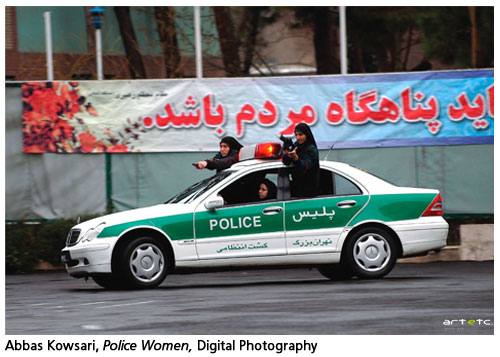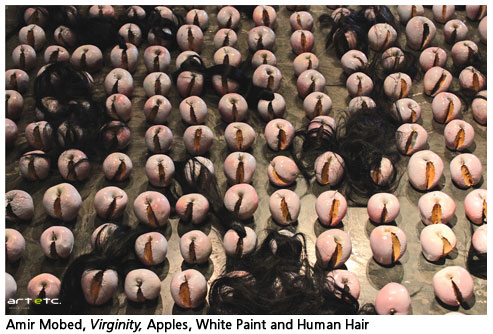[Report]
Cross Cultural Encounters
by Dr. Seema Bawa
The Indian Art Fair, and indeed any art fair is ideally about viewing and understanding arts of other cultures and societies, to broaden one's horizons by looking at the masters and emerging artists not only from the West but also China and other Asian countries. Much more, however, is the general 'curiosity' to analyze who is 'deriving' his or her ideas from which artist and where is the inspiration flowing from? In the globalised culture and information age, and its concomitant homogeneity, there is very little that remains culture specific in contemporary art. Still some shows, mainly collateral events organized by galleries in the city do stand out for either the representative and international perspective or sheer aesthetic value that they bring to the art scene.
One of the major shows is The Elephant in the Dark curated by Amirali Ghasemi at Devi Art Foundation that displays the subterranean art from Iran. Assistant curator, Reha Sodhi says that once they went to Iran they realized the experimental and subversive nature of Iranian art. She explains, “Young artists doing cutting edge work weren't published or spoken of, due to the fear of the government. The challenge while collecting and putting up this exhibition was how to give a voice to such works, stay away from the clichés and stereotypes, and represent on an equal platform, artists who are established and ones emerging.”

The show is divided into three sections that dialogue with traditional form, contemporary social and political issues. Some works do stand out in the section Reflections of a Complex Society, one such work by Abbas Kowsari interrogates social issues such as gender representation. In Police Women he photographs the graduation ceremony with a show of physical maneuvers, held at the Iranian Police Academy every year. The 'exhibition' includes performing martial arts, chasing criminals at a high speed, descending buildings with ropes, shooting, dismantling weapons with closed eyes and military marches, all done with full Islamic cover, the chador. Asserting feminine power by imitating the exercises that in a patriarchal society such as Iran are supposed to be the male domain is perhaps a distorted form of feminism; if men are strong so are we! This apparent equitable status of women is contradicted by the sharia, or Islamic Law that stipulates that a woman's testimony in a court case is valid only if two women to corroborate her story; equaling one man's statement.

A more strident feminist installation is Amir Mobed's Virginity. This work was banned immediately after it was first displayed at Arya Gallery, Tehran. Representatives of the Ministry of Islamic Culture and Guidance sought elimination of parts, especially the tissues with blood. The work was next shown in a new arrangement at Paris, with the current display being the third.
Apples with a layer of sprayed white paint become symbols of femininity. The installation is divided into two spaces, one depicting idyllic innocent apples with plaited hair, symbolizing wholeness. The second square space has its apples dismembered with messed up hair, evoking violence, abuse & sexual subjugation; perhaps referring to poverty induced prostitution, conveniently denied by the government.
 Khosrow Hassanzadeh's Gandhi project has resonances for Indian viewers and is inspired by public sufi shrines. These shrines constructed as boxes showcase photographs of Iran-Iraq martyrs surrounded by lights, flowers, mirrors, knick-knacks and painted ceramic titles.
Khosrow Hassanzadeh's Gandhi project has resonances for Indian viewers and is inspired by public sufi shrines. These shrines constructed as boxes showcase photographs of Iran-Iraq martyrs surrounded by lights, flowers, mirrors, knick-knacks and painted ceramic titles.
Omnilogue: Journey to the West, is again an exercise in intellectual exchange seen through a cultural historical lens by six leading Japanese artists. They examine the complexities of nationalism and travel, spatial, temporal as well across cultures and nationalities. Yuken Teruya explores the flow of cultural traffic through wooden block prints on cloth inspired by Jaipur-Sanganer workshops. Much of the show is based on video art and performance such as Aki Yahata's video installation that explores the interaction between a Japanese actor with a hearing disorder and an Indian actor who is visually challenged and the narrative of their journey and encounters. Through this she seeks to explore the vital issue of communication that transcends language, ideologies and cultural signifiers.
An international collaborative effort can be seen in Project Jan-Path's The January Exhibition curated by Sharmini Pereira of Raking Leaves of art enclosed in limited edition and handmade books and notebooks. Aisha Khalid's, on the one hand explores the deeply ideological and class prejudiced experience of learning Urdu and English in Pakistan, while Bani Abidi's on the other hand explores the retired life of fictional political speech writers. T. Shanaathanan pre-fronts displacement in the drawings Sri-Lankan Tamil refugees. An intimate reader-read and viewer viewed dialectic is the underlying strength of the display.
Another effort that projects multiple original editions is Multiple Encounter 2, the mega show at the Lalit Kala Akademi showcasing prints of 127 artists from India and America. The curators Anandamoy Bannerjee, Kavita Nayar, Dattatraya Apte and Sushanta Guha from the Indian side and Vijay Sharma and Nicholas Hill from the American, are committed artists who want to create awareness about prints and printmaking amongst the emerging middle class. The striking quality of the works is the matching of each artist's personal narrative with his or her studio practice. The history of Indian printmaking unfolds in the show where prints of almost all major and younger printmakers have been displayed. Works by artists from Group 8 and erstwhile Indian Printmakers Guild such as, Anupam Sud and Jagmohan Chopra alongwith Somnath Hore, provide a panoramic view of techniques and thematic employed.
The discourse that unfolds through the display moves between local and transnational concerns with Larry Collin's works pre-fronting the iconic African American heroes on the one hand, and the 'hennaed hands' that privilege Asian womanism in Valerie Hammond's prints on the other. The relevance of the future of conventional printmaking in the era of digital imaging and internet is interrogated in this show where the only unifying factor is that all the works have to incorporate traditional printmaking processes.
Tags: art






